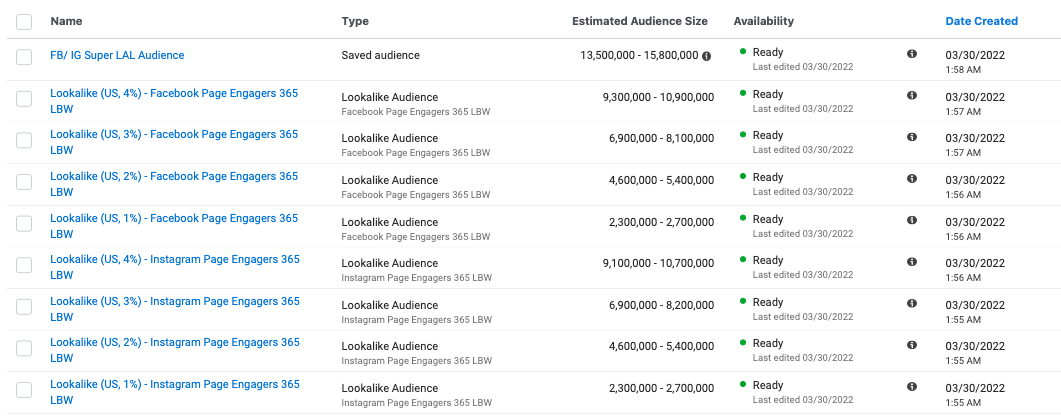The Do’s and Don’ts of Broad Prospecting
In the new landscape of paid social advertising, most customer success representatives and account managers (whether they are at Meta, TikTok, or Snapchat) are pushing broad prospecting as the new “meta” – pun intended. As a growth agency, we are approached from these representatives often, and historically speaking, advice from these representatives can be super hit and miss. They can generate some good recommendations here and there, but it’s always a good idea to validate their advice and make sure it aligns with the goals you’re trying to accomplish. In the post-iOS 14 paid social ecosystem, we’ve had ample opportunity to test this new strategy, and have created a list of general “do’s and don’ts” of broad prospecting to keep in mind.
What is broad prospecting in paid social advertising?
Broad prospecting, as we define it for this exercise, is the intentional effort of creating minimally constructed audiences. These audiences have very few parameters on them: maybe some loose demographic targeting, and a few interests or data points to reference to. These can get up to 10m+ in size, depending on the different parameters included, and are used predominantly on social ads.
Why should I use broad targeting as a part of my paid social advertising strategy?
Casting a wide net at the top of the funnel allows you to show your products to a variety of people that might not have otherwise seen them. The running hypothesis for leaning on broad prospecting as a strategy is that the pixels associated with your ad account are much, much smarter than the advertiser running the ads.
Ironic, right?
The theory has some merit: a pixel associated with your ad account collects thousands of data points, and is constantly learning. We equate it to cast iron: the more data it collects, the more seasoned it becomes, and the better the result. The whole premise of machine learning depends on the pixel being smarter than what we can come up with manually. Every bid, every ad placement, every conversion feeds the pixel more information. In theory, each action creates a larger data subset for the pixel to continue to optimize, and get better.
The do’s and don’ts of broad prospecting:
Do:
- Use a variety of lookalikes
- Test various broad prospecting techniques
- Choose a conversion oriented objective
Don’t:
- Use broad prospecting for new ad accounts
- Optimize for in-platform events
- Wait too long to make a change
The “Do’s” of Broad Prospecting:
Use Large Lookalikes:
Lookalike audiences are a powerful way to reach new people in your potential conversion pool. Work smarter, not harder. By using data you already have access to (think: past purchasers, people who have visited your website, people who have engaged with your accounts, etc), you can strategically build lookalikes of this data. Once you pick the source for your lookalike audience, you’re able to go a step further and select the percentage (of lookalike) you want to use, ranging from 1% to 10%. We have seen some of the strongest performance for our eCommerce partners with combining a mix of percentages – Example: Targeting a 1%, 2%, 3%, 4% and 5% lookalike audiences. By combining different levels of intent, you’re able to more broadly target potential customers and maximize your brand’s exposure in one fell swoop.
Test Various Targeting Techniques:
Whether you are doing light demographic guardrails, implementing various interest or behavior based targeting, or using lookalike data for your broad prospecting, we say this: move fast, test fast, learn fast. It’s the motto of David, one of our Paid Social channel experts, and I say it daily. Isolate your variables, test things in a consistent manner, and apply your learnings to your next iteration. If you have a winning strategy, isolate it into its own campaign, and continue to use the test campaign to try new ideas and refine your broad prospecting strategy. By isolating new techniques into a test campaign, you’re able to work around pushing all of your campaigns back into the learning phase (which can sometimes negatively affect performance).
Choose a Conversion Oriented Objective
Don’t waste time and money optimizing for lead generation, or one of the other productive optimization strategies on Meta. For example, if you are an eCommerce store, optimize for purchases or add to carts! If there’s one thing we’ve learned, it’s that the pixel delivers ads based on the objective and the selected conversion event.
By choosing purchasers, you’re reaching an audience that is the most likely to purchase. If you’re optimizing to add to cart, you’re reaching an audience that is most likely to add a product to the cart. If you’re broad prospecting, adding a simple guardrail of a conversion-oriented objective gives the pixel enough guidance to find the right subset of users you should be targeting in addition to your other parameters.
The “Don’ts” of Broad Prospecting:
Don’t Use Broad Prospecting for New Ad Accounts and Pixels:
The whole theory behind broad prospecting is that it uses machine learning to optimize and deliver your ads. If you have a brand new ad account, or pixel, then the machine doesn’t have enough information to create accurate and insightful learnings. We’ve mentioned “guardrails” a few times in this article: those guardrails serve the purpose of pointing the pixel in the right direction. If you have a brand new pixel without much data, there aren’t enough guardrails built in to deliver your ads effectively, and you’re better off manually targeting the audience you want to deliver ads to.
Don’t Optimize for In-Platform Events
Take for instance, lead generation ads as an example of an in-platform optimized event. In some instances these ads can be successful – But typically for highly specific goals paired with pretty narrow targeting, think retargeting people who have previously engaged with one of your leads ads. While these ads can be simple and require little effort from the user, they add a step to the process of being able to maximize the potential of this purchase intent. What do I mean by that? Well, when someone fills out your lead form then this data is typically collected in the platform. Once you have that data then you need to download the leads via Ads Manager or your Facebook Page. This seems simple enough, but generally speaking, attention spans are short. If someone is ready to convert, it’s best to capture the intent as instantaneously as possible. If you keep people waiting, the interest begins to wean off and leads might fall through the crack.
Don’t Try to Sell to Everyone
You may be speaking to a broad audience, but that doesn’t mean you should water down your message. We recommend using compelling creative that is user-generated to tell the story of your brand and why people should care. Hone in on those value propositions of your business, and test out different messaging. If you water down your message while broad prospecting, you won’t appeal strongly enough to anyone to get valuable insights for continued optimization. Pro-tip: Not sure what type of creative works best for your audience? Check this out!
Looking for help when it comes to paid social?
Look no further. Whether it’s a kick-ass creative strategy, a need for structured testing, or guidance on how to find your target audience on paid social, we’re here to help. Let’s talk!

Hey there! I’m Kate, the Head of Social at Tuff. I specialize in crafting paid social campaigns and testing performance creative to drive business results. Outside of Tuff, I enjoy tackling home renovation projects, skiing, and nerding out over the Enneagram (personality test)!







